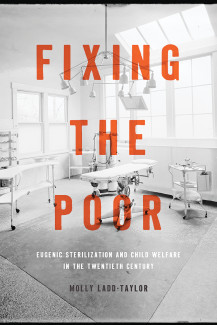
Johns Hopkins UniversityEst. 1876
America’s First Research University
Fixing the Poor: Eugenic Sterilization and Child Welfare in the Twentieth Century

When Fixing the Poor was published in 2017, eugenics seemed like a shameful episode in America’s past. Today, #eugenics is trending. Universities confront their eugenics legacies. Scientists debate whether eugenics policies would work. The White House is imposing harsh new immigration and border policies that many decry as racist and eugenic. Opponents of legal abortion, including US Supreme Court Justice Clarence Thomas, denounce abortion as “rife with the potential for eugenic manipulation.” Eugenics is back at the center of US policy debates, making historical perspectives more urgent than ever.
Fixing the Poor adds to the debate over eugenics legacies with a striking reinterpretation of one of the best-known and most-deplored eugenics policies: sterilization. My book departs from most scholars’ emphasis on eugenics discourse by focusing on the routine operation of the sterilization program in one state, Minnesota. It places poverty and administrative control of “the poor” at the heart of sterilization practice.
Eugenics was international, but US sterilization policies were enacted at the state level and addressed local concerns. Thirty-two states legalized eugenic sterilization between 1907 and 1937, resulting in the sterilization of more than 63,000 individuals. State sterilization laws varied widely, both in their statutory provisions and in the number of operations performed, but Fixing the Poor focuses on Minnesota’s relatively modest law, enacted in 1925. The Minnesota law applied only to people already under court-ordered guardianship as “feebleminded” or “insane,” and surgery was legally voluntary. Still, at least 2,350 people—80 percent of them “feebleminded”—were sterilized. For most, sterilization was the “price of freedom” from the state institution.
The story of eugenics is often told as a cautionary tale about elite arrogance and the failure of expertise. Fixing the Poor challenges this view in two ways. First, my research highlights the gap between the Minnesota Eugenics Society’s obnoxious crusade to sterilize all the unfit and sterilization’s actual function as a welfare policy. The welfare officials who wrote and administered Minnesota’s sterilization law rejected eugenicists’ shrill warnings about the menace of the “feebleminded.” Instead, they viewed Minnesota’s three-step eugenic sterilization program – judicial commitment, institutionalization, and release from the institution following surgery – as a way to “help” destitute, dependent families avoid the burdens of childrearing and become self-supporting. Controlling welfare costs, not improving the gene pool, was their central concern.

Second, experts played a surprisingly small role in determining who fit the legal definition of a “feebleminded person,” a precondition for sterilization in Minnesota. The designation of “feeblemindedness” was made by the local probate judge, an elected official not required to have any medical or legal training. Most judges knew little about eugenic theories of human heredity, but they understood the usefulness of eugenics legislation as a means for coping with local problems of delinquency, illegitimacy, and welfare dependency. Committing an indigent person to state guardianship as “feebleminded” shifted part of the cost of supporting them from the county to the state.
The attribution of disability – “feeblemindedness” and the related concept of “public charge” – legitimized eugenic mistreatments. Still, Fixing the Poor shows, judgments about “who was feebleminded” and targeted for sterilization were inconsistent. Unwed mothers, “sexually delinquent” girls, and mothers of large families on welfare were often labeled feebleminded and sterilized. But not always. The same was true for individuals with physical and mental disabilities, Indigenous people stereotyped as dependent and disorderly, and gay men. The only certainty? Every sterilized person was poor.
Women accounted for 80 percent of sterilizations in Minnesota, and their stories reveal the horrifying connections between eugenics abuse, poor women’s sexual and economic vulnerability, and the long shadow of “me too.” For example, Sarah Berger was adjudged feebleminded after she complained that a boy who had sexually molested her as a child had started bothering her again. Greta Acker was the “feebleminded” unmarried mother of her father’s child. Lillian Green started trading sex with old men for money after her father committed suicide when she was fourteen; the wife of one of these men petitioned the court to find her feebleminded and send her away to the state institution.
As Americans work to acknowledge the uncomfortable legacies of past eugenics policies and confront eugenics in the present, we should avoid the temptation to focus only on the most offensive pronouncements of eugenics polemicists. In practice, as Fixing the Poor shows, eugenic sterilization was never only about human heredity and reducing the numbers of “unfit.” From the beginning, state sterilization policies were rooted in a chronically underfunded and locally variable public welfare system that stoked public scorn for the poor and disparaged families who depended on government assistance as mentally incompetent and undeserving. This is the welfare system the US has today. Only by confronting the mundane, bureaucratic aspects of eugenics history can we begin to construct a society that is truly resistant to eugenics abuse.
Order Fixing the Poor: Eugenic Sterilization and Child Welfare in the Twentieth Century – published in paperback on March 3, 2020 – at the following link: https://jhupbooks.press.jhu.edu/title/fixing-poor
Molly Ladd-Taylor is a professor of history at York University. She is the author of Fixing the Poor: Eugenic Sterilization and Child Welfare in the Twentieth Century, Mother-Work: Women, Child Welfare, and the State, 1890–1930 and the coeditor of "Bad" Mothers: The Politics of Blame in Twentieth-Century America.



